
Unlike the now-thriving koa, the ʻōhiʻa lehua trees are dying of natural causes.
Visitors to Kīpukapuaulu often notice, with great concern, the many large, dying endemic ʻōhiʻa lehua trees (Metrosideros polymorpha). They ask whether their demise is due to a disease or insect that may be spreading throughout the islands. The good news is that the dieback of ʻōhiʻa lehua trees in Hawaiʻi is a natural phenomenon. But what, then, are killing these trees in Kīpukapuaulu? The most likely culprits are simply old age and drought. ʻŌhiʻa lehua trees colonize new lava flows and ash deposits. As a new generation, they grow up together, mature together, and die together. As these trees age, they lose their ability to handle environmental and biological stresses, such as drought, insects, and disease. The most likely stress affecting Kīpukapuaulu is the high frequency of El Niño droughts that Hawaiʻi has been experiencing since the late 1990s. The dieback you see here, and through out the rest of Kīpukapuaulu, is just part of a widespread dieback occurring on the lower slopes of Mauna Loa.
Is there something we missed for this itinerary?
Itineraries across USA

Acadia

Arches National Park

Badlands

Big Bend

Biscayne

Black Canyon Of The Gunnison

Bryce Canyon

Canyonlands

Capitol Reef

Carlsbad Caverns

Channel Islands

Congaree

Crater Lake

Cuyahoga Valley

Death Valley

Dry Tortugas

Everglades

Gateway Arch

Glacier

Grand Canyon

Grand Teton

Great Basin

Great Smoky Mountains

Guadalupe Mountains

Haleakalā

Hawaiʻi Volcanoes

Hot Springs

Indiana Dunes

Isle Royale

Joshua Tree

Kenai Fjords

Kobuk Valley

Lassen Volcanic

Mammoth Cave

Mesa Verde

Mount Rainier

North Cascades

Olympic

Petrified Forest

Pinnacles

Rocky Mountain

Saguaro

Shenandoah

Theodore Roosevelt

Virgin Islands

Voyageurs

White Sands

Wind Cave

Yellowstone

Yosemite

Zion